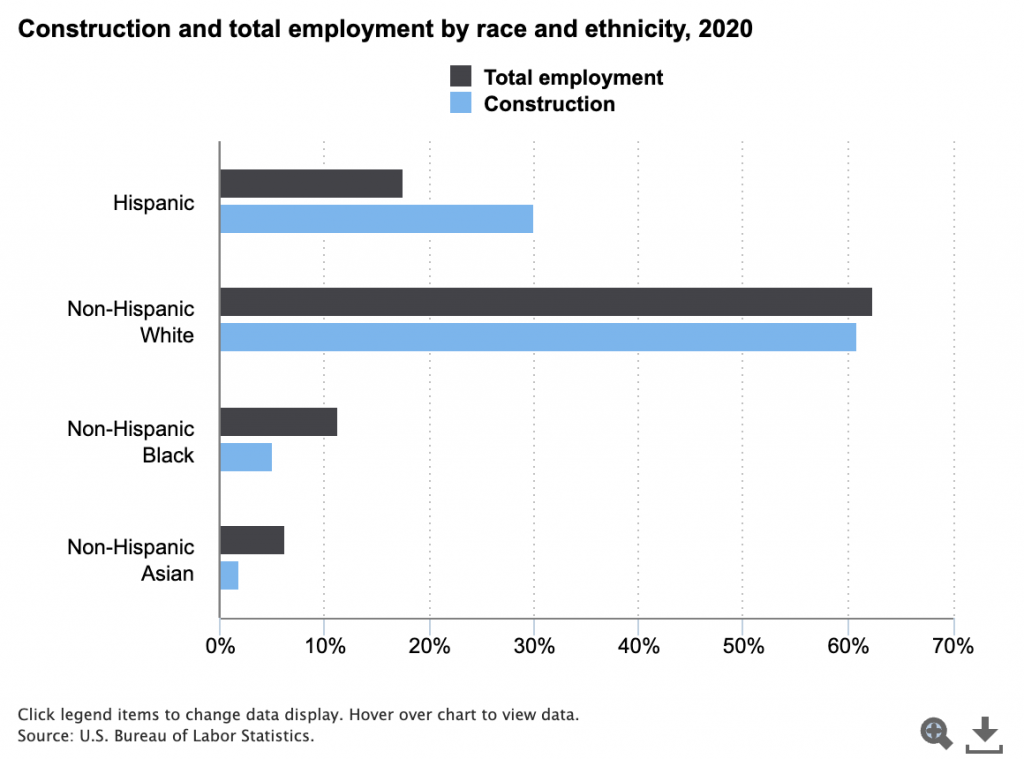-
 play_arrow
play_arrow
The real value of working in the building trades with Dave Ianucci, EAS Carpenters Chris Martin
-
 play_arrow
play_arrow
Director of Safety and suicide survivor shares how his experience is helping others in construction Building PA Podcast
-
 play_arrow
play_arrow
Construction companies win when their insurance broker is construction-centric! Building PA Podcast
- Home
- keyboard_arrow_rightComo Trabajamos Juntos – How We Work Together
Como Trabajamos Juntos – How We Work Together


It’s no secret that Hispanics form a major part of the backbone of the American workforce. According to the US Bureau of Labor Statistics, the number of Hispanics in the workforce is expected to have increased by 7.4 million from 2018 to 2028. BLS adds that approximately 3.4 million construction workers in 2018 were Hispanic or Latino. In Pennsylvania alone, the Hispanic population accounted for 7% of the construction workforce in 2020, according to the Center for Construction and Research Training.

Education
However, as strong as Hispanic participation is in the industry, there are still many people who come to the US and either struggle to find work or are unaware of the opportunities in this country. In Lebanon, PA, Rafael Torres is hoping to change that once development programs and classes open this fall at the new WEPA Empowerment Center. In addition to construction trades, the center will offer GED preparation, digital and financial literacy training, and English instruction for Hispanic people in places like Lebanon, which often receive fewer resources than big cities like Philadelphia and Pittsburgh.
According to Torres, a major component of the language barrier is that while grade schools in other countries teach English, it is often not used on a daily basis, leading to a “use it or lose it” cycle.
“That’s where the disconnect starts,” Torres says.
Another disconnect, he adds, is as simple as the upfront expectations of being a construction worker. There are customer service skills, basic aspects of work ethic, and knowledge of how to navigate conversations with supervisors that are all important for new construction workers that no one really learns in a traditional academic environment.
“In regular school, you’re just memorizing tests, and making sure that you pass,” Torres says. “You’re not really engaging in the learning process of day-to-day activities and life. So, unfortunately, we all need at one time or another some type of support services. And that’s what we’re going to be focusing on.”
Expectations
On the other side of the coin, it’s also important for workers to understand how they should expect to be treated. Roberto Saravia, a Washington, D.C.-based union organizer, says many Hispanic workers do not know about how benefits work in the US because they’re coming from countries that don’t always offer those rights.
“For example, they don’t know that they deserve a pension,” Saravia says. “They are committed to receiving health care, training, legal assistance, and all that stuff. So, the most common thing is, ‘if I go with you guys, what are the benefits that I receive?’”
In 2019, the federal Bureau of Labor Statistics reported that the weekly average earnings of unionized Latino workers were 28 percent higher than those of non-unionized Latinos.
Unionized Latinos are also 26 percent more likely to have employer-provided health insurance and 27 percent more likely to have a pension plan, and they possess ten times the wealth of non-union Latinos, according to the Washington, D.C.-based Center for Economic and Policy Research. However, BLS notes that just 9.8 percent of Latino workers are unionized. Saravia feels that may be because prospective union members who do understand their rights often have misperceptions of what a union is and what it does.
“People believe that we take all of the money for ourselves, and it’s not true,” Saravia says. “All the money that they pay on their dues goes to fund a pension, to fund health care, insurance programs, and training. … So, we are trying, we are working hard to educate them that ‘union’ is exactly what the word means.”
How do we work together
Finding opportunities to support this growing sector of the workforce will strengthen the backbone of the industry. More importantly, helping members of the Hispanic community understand the various options only solidifies their knowledge of the construction industry. As more opportunities are identified and workers understand the intricacies of the industry, we truly are working together.

Originally published in the Keystone Contractor Magazine.
Building PA Podcast - © 2023

